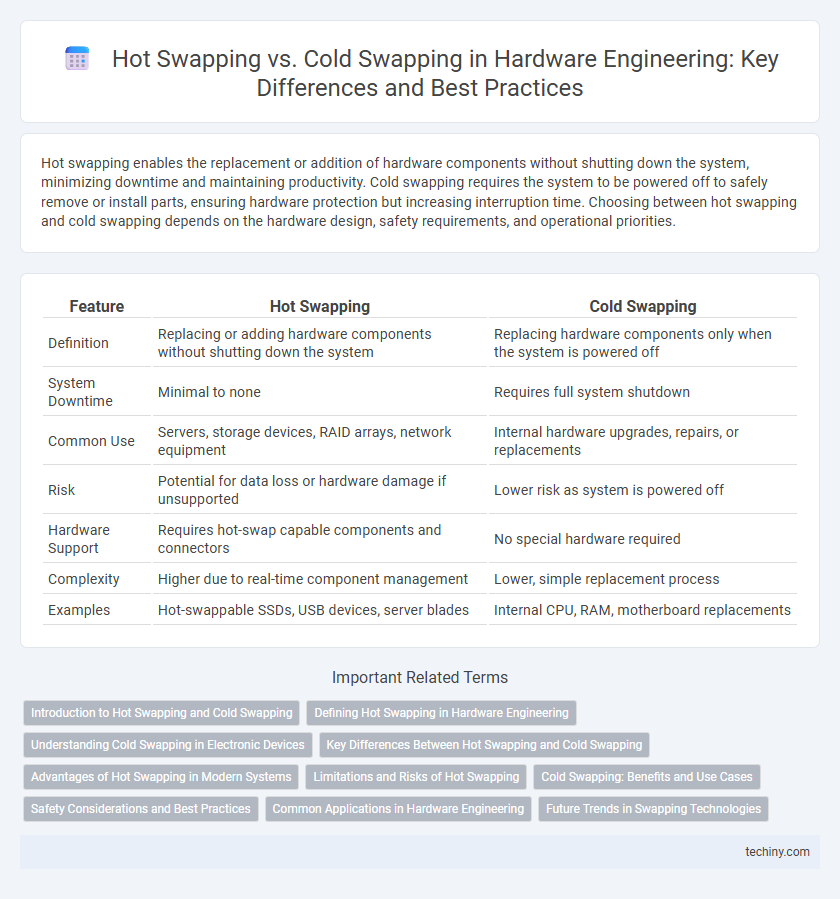Hot swapping enables the replacement or addition of hardware components without shutting down the system, minimizing downtime and maintaining productivity. Cold swapping requires the system to be powered off to safely remove or install parts, ensuring hardware protection but increasing interruption time. Choosing between hot swapping and cold swapping depends on the hardware design, safety requirements, and operational priorities.
Table of Comparison
| Feature | Hot Swapping | Cold Swapping |
|---|---|---|
| Definition | Replacing or adding hardware components without shutting down the system | Replacing hardware components only when the system is powered off |
| System Downtime | Minimal to none | Requires full system shutdown |
| Common Use | Servers, storage devices, RAID arrays, network equipment | Internal hardware upgrades, repairs, or replacements |
| Risk | Potential for data loss or hardware damage if unsupported | Lower risk as system is powered off |
| Hardware Support | Requires hot-swap capable components and connectors | No special hardware required |
| Complexity | Higher due to real-time component management | Lower, simple replacement process |
| Examples | Hot-swappable SSDs, USB devices, server blades | Internal CPU, RAM, motherboard replacements |
Introduction to Hot Swapping and Cold Swapping
Hot swapping enables the replacement or addition of hardware components without shutting down the system, minimizing downtime and maintaining continuous operation. Cold swapping requires powering down the system completely before removing or installing hardware to prevent data loss and hardware damage. Understanding the differences between these techniques is critical for designing reliable hardware systems that balance operational efficiency and safety.
Defining Hot Swapping in Hardware Engineering
Hot swapping in hardware engineering refers to the ability to add or replace components, such as hard drives or power supplies, without powering down the system. This capability minimizes downtime and maintains system availability, crucial in data centers and enterprise environments. Hardware designed for hot swapping includes robust connectors and power management to prevent damage during component exchange.
Understanding Cold Swapping in Electronic Devices
Cold swapping in electronic devices involves disconnecting or connecting hardware components only when the device is powered off, ensuring no live electrical current flows through the connectors. This method prevents potential damage to the circuit board and connected components caused by electrical arcing or short circuits during insertion or removal. Common applications include internal hard drives, memory modules, and power supplies that lack hot-swap capabilities and require system shutdown for safe handling.
Key Differences Between Hot Swapping and Cold Swapping
Hot swapping allows hardware components to be replaced or added without shutting down the system, enabling continuous operation and minimal downtime. Cold swapping requires powering off the device before making any hardware changes, which ensures safety but causes system interruption. Key differences include the risk of data loss during cold swapping, the complexity of hardware design supporting hot swapping, and the impact on system availability.
Advantages of Hot Swapping in Modern Systems
Hot swapping enables seamless replacement or addition of hardware components without powering down the system, significantly minimizing downtime and maintaining continuous operations. This capability is critical in data centers and mission-critical environments where system availability directly impacts performance and revenue. Enhanced hardware modularity and simplified maintenance workflows are additional advantages that improve overall system reliability and scalability in modern IT infrastructure.
Limitations and Risks of Hot Swapping
Hot swapping allows replacement or addition of components without shutting down the system but carries risks such as electrical short circuits, data corruption, and hardware damage if connectors are not properly aligned or if the device lacks hot-swap support. Limitations include the necessity for specialized hardware and firmware to manage power and signal integrity during live changes, which increases complexity and cost. Improper hot swapping can lead to system instability and increased downtime due to unexpected failures or the need for manual recovery procedures.
Cold Swapping: Benefits and Use Cases
Cold swapping in hardware engineering involves powering down a system before replacing or adding components, ensuring safety and preventing electrical damage. This method is beneficial for devices that lack hot swap capabilities, such as certain motherboards, power supplies, and storage drives, where maintaining system integrity is critical. Use cases include upgrading internal hardware in desktops, servers during scheduled maintenance, and replacing faulty components in environments without redundant systems.
Safety Considerations and Best Practices
Hot swapping enables the replacement or addition of hardware components without powering down the system, requiring stringent safety protocols such as using insulated tools and proper grounding to prevent electrical shock or data corruption. Cold swapping involves powering down the device before hardware changes, minimizing risks but resulting in system downtime; best practices include following manufacturer shutdown procedures and verifying device disconnection. Both methods demand adherence to electrostatic discharge (ESD) precautions and clear labeling to ensure personnel safety and hardware integrity.
Common Applications in Hardware Engineering
Hot swapping is widely employed in server environments, network equipment, and storage systems to enable seamless replacement or addition of components like hard drives and power supplies without shutting down operations. Cold swapping is typically reserved for hardware components in desktop PCs, industrial machines, and embedded systems where power disconnection is necessary to avoid data loss or hardware damage. Both methods are selected based on system design requirements, safety considerations, and operational continuity priorities in hardware engineering.
Future Trends in Swapping Technologies
Future trends in hardware swapping technologies emphasize enhanced hot swapping capabilities driven by advancements in real-time system monitoring and predictive maintenance algorithms. Emerging interfaces such as PCIe 6.0 and NVMe over Fabrics facilitate seamless component replacement with minimal downtime, improving system uptime and reliability. Integration of artificial intelligence for automated fault detection accelerates hot swap efficiency, reducing dependency on cold swapping procedures.
Hot swapping vs Cold swapping Infographic

 techiny.com
techiny.com